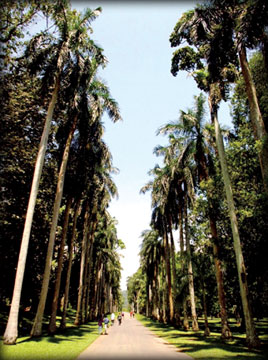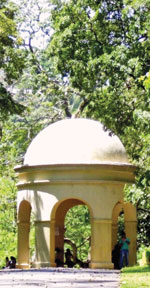|
Royal Botanical Gardens, Peradeniya :
A fascinating tale of the garden of monarchs
By Ganga Ratnayake
It is a garden snuggled in the midst of blue mountain ranges,
brimming with enthralling backdrops speckled with vivid hues.
It is a garden graced by the kings and queens and heads of states
from the world over and continues to draw over million visitors every
year.
 |
|
Vista of Royal Palm
Avenue |
It is a garden with a fascinating history that runs as far as seven
centuries. And this is the story in a nutshell, the tale of a garden
called the Royal Botanical Gardens, Peradeniya.
In February 20, 2013 I visited the Department of National Botanical
Gardens, a short distance away from the Royal Botanical Gardens,
Peradeniya along the Colombo-Kandy main road. A charming white washed
colonial building was sitting amidst a shady patch of greenery,
resonating constantly with chirpy songs of little birds. Here I met the
Director General Dr. D.S.A. Wijesundara who related an interesting and
detailed account of the garden's history, phases of development,
objectives as well as its future projects.
Garden of monarchs
According to history, the roots of the Royal Botanical Gardens dates
back to 1371 where it was first used as a garden by King Wickramabahu
III.
During the time of King Kirti Sri Rajasinghe, from 1747 to 1780, the
garden was declared as a Royal Garden and remained so till the fall of
the last kingdom, the kingdom of Kandy.
However, the idea of a botanical garden didn't come up till early
19th century.
That was when Sir Alexander Johnston, Chief Justice of Ceylon,
informed the British authorities that he wished to open a botanical
garden in Ceylon. And so under the guidance of Sir Joseph Banks - the
Director of Kew Gardens, London - a small botanical garden was set up in
Slave Island and was named as Kew Gardens. But the space wasn't enough
to fit their demands, thus the garden was moved to Uggalboda, an area
near Kalutara in 1813. As time passed they realised they required a mild
and cool climate to grow exotic plants imported from other colonial
countries. And it didn't take that long to find just the right spot, a
charming royal garden tucked away in the middle of the island.
Royal Botanical Gardens
Mr. Alexander Moon, the Superintendent of Uggalboda botanical garden,
decided to relocate the garden to Peradeniya and the moving began in
1821. In the same year the Royal Garden at Peradeniya, which used to be
graced by the kings and their entourage, was officially named as the
Royal Botanical Gardens.
Yet the journey was arduous, as hundreds of exotic plants had to be
moved over a distance of hundred kilometres and more when there were no
carpeted roadways or convenient transport available. So they had to rely
on bullock carts pulled by bulls to carry the plants along hilly
terrains and the task took a little over two decades to come to an end.
Trailblazer in research
Apart from growing economic crops like tea, rubber, cocoa, cinnamon
and coffee popular in colonial countries, the botanical garden at
Peradeniya also grew exotic vegetables for the British officials in the
country. Acclimatising exotic plants in an alien soil was no easy task,
thus British horticulturists were called for cultivating, researching
and developing plants.
 |
|
Gardner's Memorial |
They continued their research on soil and plants at a time when there
were no refrigerators, electricity, technology or modern equipments to
support them. In fact, the Royal Botanic Gardens at Peradeniya could
undoubtedly be the first scientific research institution in the island.
Apart from researching and acclimatising plants (making exotic plants
adapt to local climate), the garden had a key role of supplying fresh
vegetables to the top ranked British officials living and working in
Ceylon, regularly. Numerous vegetable crops were introduced to the
country during this time including potatoes, cabbage and carrots and
after centuries they have become part of our staple diet.
The Royal Botanical Gardens at Peradeniya thrived under the guidance
of notable Superintendents who rendered immense service to its growth
including George Gardner, Dr. G.H.K. Thwaites and Dr. Henry Trimen to
name but a few. During this era more plants were introduced and
acclimatised, more land was cultivated, books on indigenous plants were
published, more gardens were opened and even a museum of economic botany
was launched.
Department of Agriculture
Moving on from useful and ornamental plants, they began to give more
prominence to economic crops and agricultural development, which paved
the way to establishing the Department of Agriculture in 1912. And the
department took the Royal Botanic Gardens, Peradeniya under its wing
until it was separated in 2005.
As the economic crop cultivation expanded, about 300,000 labourers
from India were immigrated to work in the extensive estates in the mid
20th century.
And so to meet their consumption needs rice had to be imported from
India.
The boom in cultivation also led to many issues including pollution
and deforestation and this in turn endangered the habitats of some of
the indigenous plants.
Multifarious roles
To protect native plants found no where else in the world but in this
little island, the Royal Botanical Gardens took measures to conserve
them thoroughly. Thus, the garden became home to many of such endangered
plants which were brought from various locations of the country and
grown at Peradeniya. And this was called Ex-situ conservation, the
process of conserving a plant outside its natural habitat.
In addition to conserving plants the garden was also involved in
amenity horticulture, which covers designing, constructing and managing
the horticulture of botanical gardens and parks as well as other
recreational and leisure sites.
 |
|
Plant House |
After 1960s the garden set its sights on developing floriculture,
cultivation of flowering and ornamental plants, which has become a
highly profitable industry since then to date.
In 2005 President Mahinda Rajapaksa separated the Royal Botanical
Gardens, Peradeniya from the Department of Agriculture to boost and
streamline its services.
And the year 2006 marked the birth of a new department, the
Department of National Botanical Gardens at Peradeniya.
The office now stands in a building constructed in 1883, which was
first occupied by the Director of Gardens that time and later housed the
Department of Agriculture at its outset about a century ago.
At present there are three botanical gardens under the Department of
National Botanical Gardens, where the other two being Hakgala
(established in 1861) and Henarathgoda in Gampaha (established in 1876).
The development of two botanical gardens is underway, namely
Mirijjawila in Hambantota and Ilukowita in Avissawella.
Once completed, Mirijjawila Botanic Gardens will be the largest in
Sri Lanka covering a staggering 300 acres and will specialise in
conserving dry and arid zone plants.
By 2016 the department hopes to complete at most five more botanical
gardens and these sites have been chosen to represent the distinct
geo-climatic zones of the island.
On site education
Among its multitude of roles the Royal Botanic Gardens, Peradeniya
has taken a leading role in enlightening the school children, foreign
visitors and the masses on plants.
And taking further steps they have opened a higher education
institute called Education Centre within its picturesque premises which
conducts short and long term courses (including Higher National Diploma)
on floriculture and landscape design.
As the fascinating tale of the Royal Botanic Gardens at Peradeniya
continues to live on, many more tales will come to join the chronicles.
And when more and more gardens pop up to beautify the country, the tiny
pearl of the Indian Ocean might even boast an epithet as the paradise of
celestial gardens in time to come.
|



